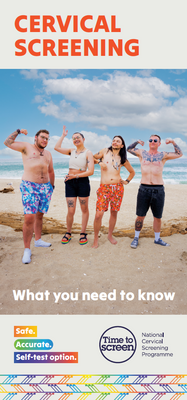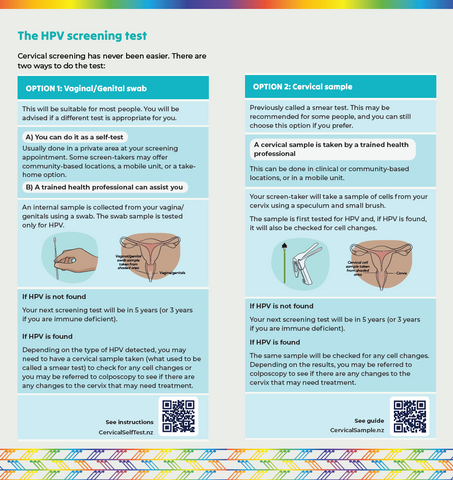Cervical screening: what you need to know English - Rainbow - HE1192

Information about the HPV cervical screening self-test option. Designed to help people decide if the test is right for them.
The full resource:
Kia ora and welcome
Cervical screening looks for the human papillomavirus (HPV) that causes most cervical
cancers. You can do the test yourself, usually in a private area at your screening appointment, or you can ask for help to get it done. Some screen-takers may offer other locations, including community settings, mobile units and even taking the test home to do and return. This won’t be the case for all healthcare providers so check what options are available in your area.
By having regular screening (usually every 5 years) and being immunised against HPV, you can protect yourself against cervical cancer. This way you can stay healthy for yourself and your whānau.
How do I know if I'm eligible for cervical screening?
Cervical screening is recommended if you are:
- a person with a cervix;
- aged between 25 and 69;
- sexually active or have ever been.
It makes no difference what your sexuality or gender identity is, or if you have not been
sexually active for a long time. If you have a cervix, get tested.
If you’ve had a total hysterectomy (removal of the uterus and cervix) check with your healthcare provider to see if you still need to have screening.
If you’re pregnant, it is safe to do the test.
If you’ve got your period, you can still have a screening test, as long as bleeding isn’t too heavy because this could affect the test result.
Funding for screening
The National Cervical Screening Programme (NCSP) is not fully funded. However, screening is free for people with a cervix who:
- are aged 30 or over and have never had a screening test or are under-screened
- require follow-up testing
- hold a Community Services Card
- are Māori or Pacific.
Where do I go for cervical screening?
Your choices include:
- your usual doctor or nurse at a GP clinic, if you have one
- Māori, Pacific or community health centres
- outreach services, like marae or mobile units
- Family Planning clinics
- sexual health services (as part of a full consult visit).
Some healthcare providers may offer a take-home option, talk to them if this is of interest to you.
You may take a support person with you to your appointment. When booking, mention if you need an interpreter or if you have a disability that means you need support.
How often do I need cervical screening?
Cervical screening is recommended every 5 years for most people (or 3-yearly if you are immune deficient). In some circumstances, you may need to have a test more often. Your healthcare provider will discuss this with you if you do.
The screening gap is safe because if you don’t have HPV, your risk of developing cell changes that may lead to cancer is very low. However, it is important to continue to have regular screening as long as you remain eligible.
HPV and cervical cancer
Almost all cervical cancer is caused by HPV. The virus is very common and is spread by intimate skin-to-skin contact or any sexual activity (not just penetrative sex).
Most adults, who have been sexually active, will have HPV at some time in their lives. The body usually clears the virus, but some types can persist and go on to cause cell changes that may, over time, turn into cancer.
Having HPV does not mean you have cancer.
Cervical cancer usually takes 10 or more years to develop. There are many stages between getting the virus, cell changes and cancer. Regular screening can find cell changes early so they can be treated before they become cancer.

The HPV screening test
Cervical screening has never been easier. There are two ways to do the test:

OPTION 1: Vaginal/Genital swab
This will be suitable for most people. You will be advised if a different test is appropriate for you.
OPTION 2: Cervical sample
Previously called a smear test. This may be recommended for some people, and you can still choose this option if you prefer.
A cervical sample is taken by a trained health professional
This can be done in clinical or community-based locations, or in a mobile unit.
Your screen-taker will take a sample of cells from your cervix using a speculum and small brush.
The sample is first tested for HPV and, if HPV is found, it will also be checked for cell changes.
Your HPV result will usually come back within 1 to 2 weeks. Talk to your healthcare provider about how you’d like to be contacted.
The HPV test is very sensitive and accurate at detecting the virus that causes most cervical cancers. The test is just as good whether you do it yourself, get your healthcare provider to help, or have a cervical sample taken. However, no test is perfect and there’s a very small chance that HPV or cell changes could be missed. That’s why it is so important to have regular screening.
Follow-up tests – what to expect
- Cervical sample
An instrument called a speculum is used to open the vagina so the doctor or nurse can see the cervix. You may either lie on your side or on your back with your knees bent. The lower part of your body will be covered with a sheet. A soft brush is used to gently take a sample of cells from the surface. This can feel a little uncomfortable.
Your sample is then sent to a lab to be checked for cell changes.

- Colposcopy
During a colposcopy, a specialist uses a microscope, called a colposcope, to check the cells on your cervix. The colposcope looks like a pair of binoculars on a stand. It magnifies the cervix so that any cell changes can be seen.
The examination may include taking a small sample of tissue (a biopsy). The biopsy takes only a couple of seconds and may be a bit uncomfortable.
It is important to attend your colposcopy appointment even if you don’t have any symptoms, and/or you are pregnant.
These extra checks may not find anything to be concerned about. If cell changes are found, you will be offered treatment, which is usually highly successful.
With vaccination and HPV testing, Aotearoa New Zealand aims to eliminate cervical cancer in the future. Together we can do this!
The HPV vaccine
HPV vaccination is an important step in protecting against cervical cancer. The vaccine is free for everyone aged 9 to 26 years, including non-residents under 18. HPV vaccination has led to a drop in cervical cancer rates, but it doesn’t protect against all types of HPV. Even if you’ve had the vaccine, it’s still important to have regular cervical screening.
An important message
Cervical screening is for people who don’t have symptoms. If you’re having any symptoms, it is important to see a healthcare provider without delay. Symptoms could include:
- bleeding or spotting between periods or after your periods have stopped (after menopause)
- pain during sex and/or bleeding or spotting after sex
- vaginal discharge that’s not normal for you
- persistent pain in your pelvis or lower back.
These symptoms can happen for many reasons and rarely mean you have cervical cancer. However, it is important to get them checked.
How do I join the National Cervical Screening Programme?
You automatically become part of the Programme, if you are eligible, when you turn 25 or have your first cervical screening test, unless you have chosen to withdraw.
You need to be on the NCSP-Register to get an invitation, recalls and reminders to screen. If you are not sure if you are on the Register, call 0800 729 729 to check.
What happens to my health information?
Information is stored on a computer system, called the NCSP-Register, which is managed by Te Whatu Ora – Health New Zealand. The NCSP-Register is used to record your test results. This helps ensure important information is available to you and your healthcare providers and to manage your progress through the Programme. It also:
- sends out recalls and reminders
- supports you if you need support accessing cervical screening services
- provides information to enable evaluation and review of the Programme
- enables research, approved by an ethics committee
- helps with planning for national and regional services.
No reports or research produced will identify any individual.
You can look at the privacy section on Time to Screen - National Screening Unit for full details about how information collected by the Programme is securely managed.
You have a right to request your health information at any time by freephoning 0800 729 729 or emailing info@ncspregister.health.nz and verifying your identity (full name, date of birth, NHI, address).
Pausing screening or withdrawing from the NCSP
You can choose to withdraw from the NCSP at any time, or you can remain on the Register but opt out of receiving any communications. You can contact the Programme about either of these options and if you decide to withdraw, we will send you a form to complete. You can also find the form on our website. We will keep some of your identity details in our system with a note not to contact you again. All information about your cervical screening tests and history will be removed from our records.
You can re-join the Programme any time if you change your mind.
More information
If you have any further questions about the benefits of cervical screening and your options, you can usually find the answers on TimeToCervicalScreen.nz
This brochure and other cervical screening information are available from HealthEd including these helpful resources:
- Cervical Screening: Understanding test results, code HE1193
- Cervical screening self-test: What you need to know English, code HE1195
- Colposcopy: What you need to know, code HE1197
For more information and to make sure your contact details are up-to-date, talk to your healthcare provider or the NCSP-Register. Freephone 0800 729 729 or email info@ncspregister.health.nz